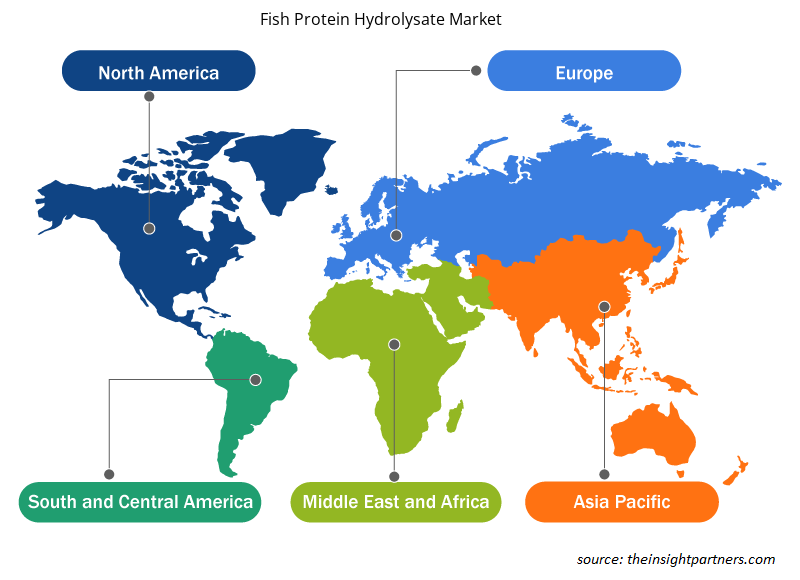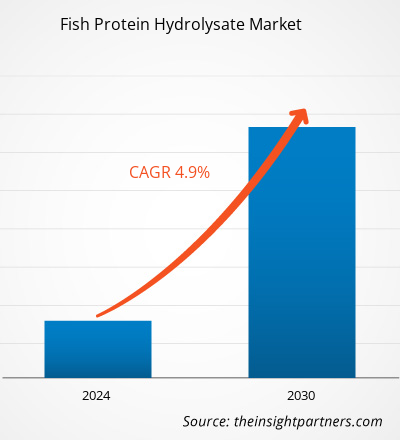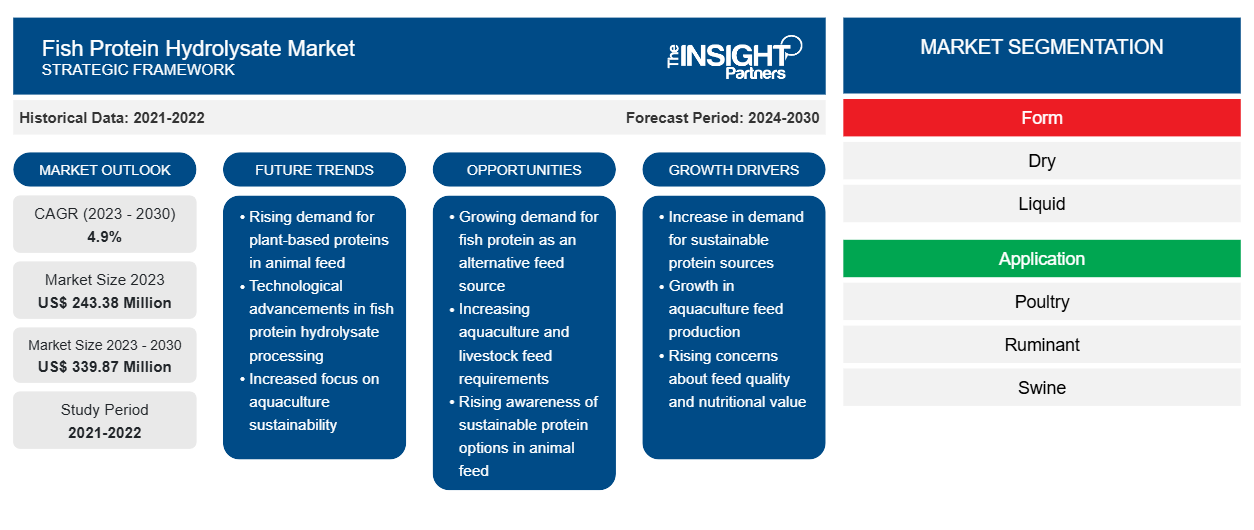[Forschungsbericht] Der Markt für Fischproteinhydrolysate für Tierfutteranwendungen wird voraussichtlich von 243,38 Millionen US-Dollar im Jahr 2023 auf 339,87 Millionen US-Dollar im Jahr 2030 wachsen; von 2023 bis 2030 wird eine durchschnittliche jährliche Wachstumsrate von 4,9 % geschätzt.
Fischproteinhydrolysat ist ein Produkt, das aus Fisch oder Fischmaterial durch Proteinhydrolyse hergestellt wird. Fischproteinhydrolysat ist also eine Mischung aus aufgebrochenen Proteinen. Fischproteinhydrolysate sollen im Vergleich zum Ursprungsprotein eine Reihe verbesserter Eigenschaften aufweisen, nämlich verbesserte funktionelle Eigenschaften und bioaktive Eigenschaften wie antioxidative oder blutdrucksenkende Wirkung. In letzter Zeit wird Fischproteinhydrolysat auch als Kryoprotektivum für gefrorene Fischprodukte verwendet. Diese Faktoren werden voraussichtlich das Marktwachstum von Fischproteinhydrolysat für Tierfutter im Prognosezeitraum vorantreiben.
Im Jahr 2022 hatte der asiatisch-pazifische Raum den größten Anteil am globalen Markt für Fischproteinhydrolysat für Tierfutteranwendungen. Laut dem Bericht der Ernährungs- und Landwirtschaftsorganisation der Vereinigten Staaten von Amerika (FAO) 2021 ist der asiatisch-pazifische Raum ein bedeutender Markt für die Aquakulturproduktion . Die asiatischen Länder waren die Hauptproduzenten und machten 70 % der gesamten Fischerei- und Aquakulturproduktion von Wassertieren aus. Fischproteinhydrolysat ist eine wichtige Zutat, die eine wichtige Anforderung der Futtermittelhersteller darstellt. Die Verfügbarkeit von Peptiden mit niedrigem Molekulargewicht und freien Aminosäuren im Fischproteinhydrolysat verbessert die Schmackhaftigkeit des Futters und stimuliert die Futteraufnahme der Fische. Daher steigt die Nachfrage nach Fischproteinhydrolysat bei den Tierfutterherstellern.
Passen Sie diesen Bericht Ihren Anforderungen an
Sie erhalten kostenlose Anpassungen an jedem Bericht, einschließlich Teilen dieses Berichts oder einer Analyse auf Länderebene, eines Excel-Datenpakets sowie tolle Angebote und Rabatte für Start-ups und Universitäten.
-
Holen Sie sich die wichtigsten Markttrends aus diesem Bericht.Dieses KOSTENLOSE Beispiel umfasst eine Datenanalyse von Markttrends bis hin zu Schätzungen und Prognosen.
Auswirkungen der COVID-19-Pandemie auf den Markt für Fischproteinhydrolysate für Tierfutteranwendungen
Die Futtermittelindustrie stand vor entscheidenden Herausforderungen wie einem Mangel an Rohstoffen und Arbeitskräften, einem Anstieg der Rohstoffpreise und Störungen der Vertriebsnetze aufgrund von Lockdowns, Reiseverboten, Handelsbeschränkungen, Fabrikschließungen und anderen staatlich verhängten Beschränkungen auf der ganzen Welt. Dies behinderte die Produktionsaktivitäten verschiedener Unternehmen der Tierfutterindustrie und führte in der Folge zu höheren Preisen für Futterzutaten. In der Europäischen Union wiesen etwa zwei Drittel der Mitgliedstaaten auf den Anstieg der Futtermittelpreise in der Viehwirtschaft während der Pandemie hin. Darüber hinaus schloss China während des Höhepunktes der Pandemie in den meisten Regionen den Vieh- und Geflügelhandel sowie die Schlachtmärkte. Solche Barrieren in der Viehwirtschaft behinderten die Nachfrage nach Futterzutaten, was sich während der Pandemie negativ auf die Nachfrage nach Fischproteinhydrolysat für Futtermittel auswirkte.
Im Jahr 2021 nahmen viele Volkswirtschaften ihre Produktion wieder auf, nachdem ihre Regierungen Lockerungen der zuvor verhängten Beschränkungen ankündigten, was dem globalen Markt Auftrieb gab. Darüber hinaus durften die Hersteller mit voller Kapazität arbeiten, was ihnen half, die Lücke zwischen Angebot und Nachfrage sowie andere Auswirkungen zu überwinden.
Markteinblicke
Ernährungsphysiologische Vorteile von Fischproteinhydrolysat in der Tierernährung
Laut der Weltorganisation für Tiergesundheit können mehr als 50 Wildtierkrankheiten die Gesundheit von Nutztieren und der Bevölkerung ernsthaft beeinträchtigen. In diesem Fall ist die Umsetzung geeigneter Ernährungsstrategien, die das Immunsystem stärken, die Gesundheit der Tiere fördern, die Integrität und Funktionalität des Darms verbessern, um die Stresstoleranz der Tiere zu verbessern und verschiedene Krankheiten zu behandeln, von entscheidender Bedeutung. Daher werden Fischproteinhydrolysate für Tierfutteranwendungen verwendet, um den Nährstoffbedarf von Nutztieren zu decken. Fischproteinhydrolysat ist eine gute Quelle für Protein und Nährstoffe wie Phosphor, Kalzium und andere Mineralien. Es hilft, die Ausbreitung von Infektionskrankheiten zu verhindern und stärkt die Immunität der Tiere gegen Pilze, Bakterien, Viren und Parasiten. Der regelmäßige Verzehr von Fischproteinhydrolysat durch Masthühner fördert deren Muskelentwicklung. Die im Fischproteinhydrolysat enthaltenen Enzyme unterstützen die Darmmorphologie von Masthühnern, indem sie die Verdauung von faseriger Nahrung, einschließlich Getreide und Sojamehl, erleichtern. Die ernährungsphysiologischen Vorteile von Fischproteinhydrolysat in Bezug auf die Tiergesundheit treiben daher seine Nachfrage in der Tierfutterindustrie an.
Formularbasierte Erkenntnisse
Basierend auf der Form ist der globale Markt für Fischproteinhydrolysat für Tierfutteranwendungen in trocken und flüssig unterteilt. Das Trockensegment hielt 2021 einen größeren Anteil am globalen Markt für Fischproteinhydrolysat für Tierfutteranwendungen und wird voraussichtlich von 2022 bis 2030 eine höhere CAGR verzeichnen. Fischproteinhydrolysat in trockener Form wird aufgrund seiner hervorragenden physikochemischen Stabilität, seiner längeren Haltbarkeit und seiner einfachen Transportierbarkeit deutlich bevorzugt. Die Bioverfügbarkeit von Fischproteinhydrolysat in trockener Form ist schnell und weniger anfällig für mikrobielle Angriffe. Solche Vorteile von Fischproteinhydrolysat haben seine Verwendung in Tierfutterherstellungsprozessen stark ansteigen lassen. All diese Faktoren treiben den Markt für das Segment an.
Zu den wichtigsten Akteuren auf dem globalen Markt für Fischproteinhydrolysate für Tierfutter zählen Copalis Industry SAS, NAN Group JSC, Scanbio Marine Group AS, Janatha Fish Meal & Oil Products, 21 Pine Freezers Road Pty Ltd, Symrise AG, Kemin Industries Inc, Euro Feed Services, Holland BV, Bio-marine Ingredients Ireland Ltd und Vita Actives Ltd. Die Marktteilnehmer konzentrieren sich darauf, qualitativ hochwertige Produkte anzubieten, um die Kundennachfrage zu erfüllen. Sie konzentrieren sich auch auf Strategien wie Investitionen in Forschungs- und Entwicklungsaktivitäten, Partnerschaften und Expansion.
Regionale Einblicke in den Markt für Fischproteinhydrolysate
Die regionalen Trends und Faktoren, die den Markt für Fischproteinhydrolysat im Prognosezeitraum beeinflussen, wurden von den Analysten von Insight Partners ausführlich erläutert. In diesem Abschnitt werden auch die Marktsegmente und die Geografie für Fischproteinhydrolysat in Nordamerika, Europa, im asiatisch-pazifischen Raum, im Nahen Osten und Afrika sowie in Süd- und Mittelamerika erörtert.

- Erhalten Sie regionale Daten zum Fischproteinhydrolysatmarkt
Umfang des Marktberichts über Fischproteinhydrolysate
| Berichtsattribut | Details |
|---|---|
| Marktgröße im Jahr 2023 | 243,38 Millionen US-Dollar |
| Marktgröße bis 2030 | 339,87 Millionen US-Dollar |
| Globale CAGR (2023 - 2030) | 4,9 % |
| Historische Daten | 2021-2022 |
| Prognosezeitraum | 2024–2030 |
| Abgedeckte Segmente |
Nach Formular
|
| Abgedeckte Regionen und Länder |
Nordamerika
|
| Marktführer und wichtige Unternehmensprofile |
|
Dichte der Marktteilnehmer für Fischproteinhydrolysat: Auswirkungen auf die Geschäftsdynamik verstehen
Der Markt für Fischproteinhydrolysate wächst rasant, angetrieben durch die steigende Nachfrage der Endverbraucher aufgrund von Faktoren wie sich entwickelnden Verbraucherpräferenzen, technologischen Fortschritten und einem größeren Bewusstsein für die Vorteile des Produkts. Mit steigender Nachfrage erweitern Unternehmen ihr Angebot, entwickeln Innovationen, um die Bedürfnisse der Verbraucher zu erfüllen, und nutzen neue Trends, was das Marktwachstum weiter ankurbelt.
Die Marktteilnehmerdichte bezieht sich auf die Verteilung von Firmen oder Unternehmen, die in einem bestimmten Markt oder einer bestimmten Branche tätig sind. Sie gibt an, wie viele Wettbewerber (Marktteilnehmer) in einem bestimmten Marktraum im Verhältnis zu seiner Größe oder seinem gesamten Marktwert präsent sind.
Die wichtigsten auf dem Markt für Fischproteinhydrolysate tätigen Unternehmen sind:
- Copalis Industrie SAS
- NAN Group JSC
- Scanbio Marine Group AS
- Janatha Fischmehl und Ölprodukte
- 21 Pine Freezers Road Pty Ltd
Haftungsausschluss : Die oben aufgeführten Unternehmen sind nicht in einer bestimmten Reihenfolge aufgeführt.

- Überblick über die wichtigsten Akteure auf dem Fischproteinhydrolysatmarkt
Bericht-Spotlights
- Progressive Branchentrends auf dem Markt für Fischproteinhydrolysate für Tierfutteranwendungen helfen den Akteuren bei der Entwicklung wirksamer langfristiger Strategien
- Von Industrie- und Entwicklungsländern übernommene Strategien für Unternehmenswachstum
- Quantitative Analyse des Fischproteinhydrolysatmarktes für Tierfutteranwendungen von 2020 bis 2030
- Schätzung der weltweiten Nachfrage nach Fischproteinhydrolysat in der Tierfutterindustrie
- PEST-Analyse zur Veranschaulichung der politischen, wirtschaftlichen, sozialen und technologischen Faktoren, die sich auf den globalen Markt für Fischproteinhydrolysate für das Anwendungswachstum in Tierfutter auswirken.
- Aktuelle Entwicklungen zum Verständnis des wettbewerbsorientierten Marktszenarios
- Markttrends und -aussichten sowie Faktoren, die das Wachstum des Fischproteinhydrolysatmarktes für Tierfutteranwendungen vorantreiben und bremsen
- Unterstützung im Entscheidungsprozess durch Aufzeigen von Marktstrategien, die das kommerzielle Interesse untermauern und zum Marktwachstum führen
- Marktgröße von Fischproteinhydrolysat für die Anwendung in Tierfutter an verschiedenen Knotenpunkten
- Detaillierte Übersicht und Segmentierung des Marktes sowie der Fischproteinhydrolysat-Industriedynamik für Tierfutter
- Größe des Fischproteinhydrolysatmarktes für Tierfutteranwendungen in verschiedenen Regionen mit vielversprechenden Wachstumschancen
- Historische Analyse (2 Jahre), Basisjahr, Prognose (7 Jahre) mit CAGR
- PEST- und SWOT-Analyse
- Marktgröße Wert/Volumen – Global, Regional, Land
- Branchen- und Wettbewerbslandschaft
- Excel-Datensatz
Aktuelle Berichte
Erfahrungsberichte
Grund zum Kauf
- Fundierte Entscheidungsfindung
- Marktdynamik verstehen
- Wettbewerbsanalyse
- Kundeneinblicke
- Marktprognosen
- Risikominimierung
- Strategische Planung
- Investitionsbegründung
- Identifizierung neuer Märkte
- Verbesserung von Marketingstrategien
- Steigerung der Betriebseffizienz
- Anpassung an regulatorische Trends























 Kostenlose Probe anfordern für - Markt für Fischproteinhydrolysate
Kostenlose Probe anfordern für - Markt für Fischproteinhydrolysate